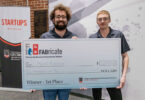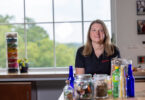Athens, Ga. – The smell of freshly cut grass may stir memories of baseball parks, cookouts or lazy summer afternoons in the suburbs, but what we perceive as a sweet aroma is actually the plant equivalent of a distress call, one that the grass releases to signal that the lawn is under attack.
The same thing happens frequently in vegetation all around us, but it goes unnoticed because humans normally don’t have the ability to smell or see the special compounds called green leaf volatiles that other plant species emit when they are damaged by pests or disease.
“Plants have a defense mechanism in which they release unique chemicals as means of communicating with other plants,” said University of Georgia researcher Ramaraja Ramasamy. “And the signature is very specific to the type of stress that is experienced by the plants.”
Ramasamy, an assistant professor in the College of Engineering, is currently developing a chemical sensor to detect these odorless, invisible volatiles that foretell plant distress well before they show signs of disease or trauma.
The sensor has a variety of potential applications, but he hopes his work will have its greatest impact on farms and food storage facilities.
Crop losses due to plant pests and pathogens cost American farmers an estimated $33 billion dollars annually, according to the U.S. Department of Agriculture, and producers spend millions of dollars spraying pesticides, herbicides and fungicides on their fields to keep yields as high as possible.
Rather than spray entire fields with expensive chemicals as a preventive measure, Ramasamy hopes that farmers could rely on sensors that identify specific sectors of a field that are under stress.
“You can create a network of sensors on a large field, and it can tell the farmer where the infection is,” he said. “Then, he can localize the application of pesticides or herbicides.”
Localized spraying would spare farmers the expense of treating their entire crop while simultaneously reducing the amount of chemicals applied to foods.
But the sensor also promises to help prevent crop losses due to spoilage that occurs off the field when fruits, vegetables and other foods are stored in large containers to await distribution.
Just like in our kitchens at home, farmers can only tell when food is going bad by the blemishes, discoloration and smells that result from decomposition. Ramasamy’s proposed sensor could detect the very earliest signals of spoilage long before it becomes apparent to humans.
“If you have a big bag of onions, for example, and one onion goes bad, that’s going to affect the other onions in the bag,” he said. “By the time you notice a bad onion, it’s probably too late, but if you can detect that spoilage in advance, you can isolate it and prevent it from spreading.”
The sensor that promises to make all this possible works much like glucose meters used by those with diabetes or hypoglycemia to test blood sugar levels. A glucose meter is designed to only recognize sugar so it is not confused by the myriad of other chemicals and compounds found within human blood.
Similarly, Ramasamy’s sensor is designed to only identify specific molecules associated with plant distress or decay—so that the dust, pollen, pesticides and other elements floating through the atmosphere won’t confuse it.
Moreover, the sensor is able to detect extraordinarily small levels of green leaf volatiles, making it incredibly sensitive to the earliest signs of distress.
Ramasamy recently published his research into the detection of three plant volatiles in Analyst, a scientific journal published by the Royal Society of Chemistry. His current research, which is funded in part through a grant from the National Science Foundation, is focused on detection of a specific chemical released by many vegetative crops when they are attacked by a pathogenic infection.
He hopes to have a device ready for testing once he and his UGA collaborators, William Whitman and Glen Rains, have optimized the technology for field use.
To read Ramasamy’s article in Analyst, see http://pubs.rsc.org/en/content/articlelanding/2012/an/c2an35350d.




